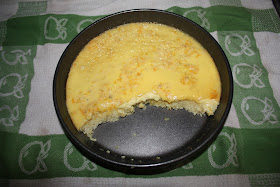In keeping with the spinach & cheese theme of yesterday, I tried my hand at making a Weight Watchers Spinach & Ricotta quiche. Have you ever realised, during the preparation and/or cooking process, that what you are making does not even slightly resemble the picture in the cookbook? Well, this happened to me. I was shattered. My first attempt at making a quiche and I failed. But then I had a thought; what is the big deal if my quiche doesn't look exactly like the picture in the book? It seems to be the little imperfections that really make our lives what they are; completely random and exhilarating. So I embraced my lopsided quiche for what it was; imperfect but beautiful in its flaws...and extremely delicious.
(Note- I also changed the recipe slightly which may have been the reason for the difference in the finished product! Personally, I think cooking is much less fun when you are bound to follow every single little step with exact precision. It makes me feel like I am back in school).
Ingredients
- 1 sheet frozen reduced-fat puff pastry, partially thawed
- in my experience you may need 2 sheets if you do not have a 22cm 'fluted flan tin', which I do not think many people have lying around.
- 2 teaspoons olive oil
- 1 brown onion, finely chopped
- 1 garlic clove, crushed
- 160g frozen chopped spinach, thawed
- If you witnessed my rant with yesterday's dish, do not use frozen spinach!! The taste is so incredibly bland compared to if you use fresh english spinach and wilt it for a few minutes with a dash of olive oil and crushed garlic in a saucepan. I used 1 medium sized bunch of english spinach for this recipe.
- 3/4 cup (150g) reduced-fat fresh ricotta cheese
- 1/2 cup (40g) grated parmesan cheese
- or any other grated cheese that you have on hand.
- 4 eggs
- 1/4 cup (60ml) low-fat milk
Cooking
1. Wilt spinach by placing it in a medium saucepan with a dash of olive oil and 1-2 teaspoons of crushed garlic. This will take around 3-5 minutes. Remove from heat and let spinach cool. When cooled, squeeze excess moisture from spinach and chop.
2. Preheat oven to 200 degrees Celsius or 180 degree fan forced. Lightly spray a 22cm (base measurement) fluted flan tin with oil. Line tin with pastry. Like I said above, I am not in possession of this very particular type of tin so I used a 30 cm pie dish, which is less shallow. As a result, you may need to use 2 sheets of pastry. If you are not so fussed about your quiche looking perfect, don't trim the excess pastry.
3. Place tin on baking tray. Cover pastry with baking paper and fill with ceramic pie weights. Now I am also not in possession of pie weights. Uncooked rice or dried beans also work well. Bake for 10-15 minutes. Remove weights/rice/beans and paper and cook for another 3-5 minutes or until base is golden.
4. In the meantime, heat oil in a large non-stick frying pan over medium-high heat. Add onion and cook, stirring for 3-5 minutes or until softened. Add garlic and cook, stirring, for 30 seconds. Depending on how much garlic you used to wilt the spinach, you may not want to add additional garlic. In my opinion, you can never have too much garlic. (Fun fact: garlic is a natural antibiotic and it appears that the body has built up less of a resistance to this vegetable/herb than many modern pharmaceutical antibiotics. Just goes to show that the best stuff for our bodies really does come from the ground).
5. Place spinach, onion mixture, ricotta and parmesan (or other cheese) in a bowl. Whisk eggs and milk in a jug until combined. Season with salt and freshly ground black pepper. Sprinkle spinach mixture over pastry in tin. Pour egg mixture over spinach. Bake for 25-30 minutes or until pastry is golden and the egg has set. Stand quiche for 5 minutes before removing from the tin.
Serve with a salad if you like. I made one of my favourite salads with chick peas, tomato, cucumber, red onion, avocado and balsamic vinegar as a dressing,
Preparation time: 15 minutes
Cooking time: 45 minutes
x E



























































